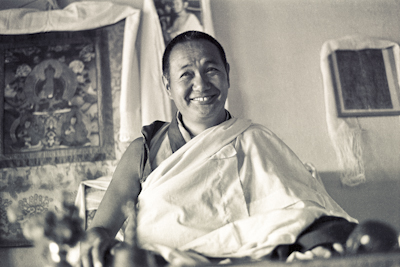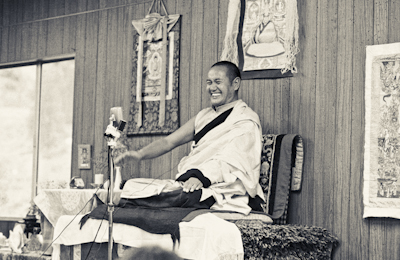
Lama Yeshe teaching in the gompa (shrineroom) at Kopan Monastery, Nepal, 1974.
I want you to understand clearly that we distinguish between these two things: negative, or sinful, and positive. Attachment, or desire, can be negative and sinful, but it can also be positive.
The positive aspect is that which produces pleasure: samsaric pleasure, human pleasure—the ability to enjoy the world, to see it as beautiful, to have whatever you find attractive.
So you cannot say that all desire is negative and produces only pain. Wrong. You should not think like that. Desire can produce pleasure—but only temporary pleasure. That’s the distinction. It’s temporary pleasure.
And we don’t say that temporal pleasure is always bad, that you should reject it. If you reject temporal pleasure, then what’s left? You haven’t attained eternal happiness yet, so all that’s left is misery.
But you should not make the mistake of trying to actualize temporary pleasure [as an end in itself]. You can enjoy it while you have it but you should not squeeze yourself striving for it. The problem is the mind that believes temporary pleasure to be the best there is. That’s a total delusion, an over-estimated conception. Like looking at a cloud in the sky and thinking, “What a beautiful cloud; I wish it would last forever.” You’re dreaming.
We should recognize all our human pleasures as similarly impermanent. They come; they go. They’re limited and we should expect them to be limited. That’s their nature. Our expectations should always be in accord with the way things are. Therefore we should not grasp at temporary pleasure as if it were eternal, everlasting happiness. That’s deluded, a fantasy.

Lama Yeshe after the Sixth Meditation Course, Kopan Monastery, Nepal, 1974.
Of course, the lam-rim and Mahayana Buddhism in general talk about attachment and self-cherishing as incredibly big problems. And when you hear that, you might think, “I want to give them up today!” You can’t. It’s impossible; you’re too ambitious. You need to understand that attachment is a problem in everyday life because you have too many fixed ideas and unreasonable expectations. You can’t give all that up overnight. Work it out slowly: “I’m grateful to understand how attachment works, but it will take time to overcome it. There are certain things I can handle now but I can’t manage everything at once.”
Remember what I said about the mixed eight worldly dharmas—actions that are a little bit white and a little bit black so that the results are mixed too; not totally negative. So you have to see where you fall in this and use your own judgment when deciding how to deal with your own attachment. Just don’t look at all attachment as completely negative. It’s not. There are degrees of attachment.
You’ve probably heard about the five paths and the ten bodhisattva levels (bhumi). For example, there are the paths of merit, preparation and right seeing, at which point one attains the first bhumi. It’s quite a long journey. From there up to the eighth bhumi, you can still have some attachment. As I said, it has degrees.
Knowing this, we beginners should be encouraged that it is only when we reach the incredibly high eighth bodhisattva bhumi that we are completely free of attachment. Starting from where we are, we first deal with its gross levels and slowly, slowly rid ourselves of it.
So don’t be too idealistic: “How fantastic. Lama has told me all about attachment,” and then go home and tell your father, “Your problem is attachment,” your boyfriend, “Your problem is attachment.” Everything is attachment. Then people start telling you, “You know what? Your problem is attachment.”
Well, philosophically, we might understand attachment clean clear, but in practice we have to be reasonable and, as the lam-rim explains, have a realistic attitude towards attachment. So, if you see some benefit for yourself or others in doing something, even small, although it might be tinged by attachment, do it. Do what you can; that’s good enough.
When some Westerners first encounter the lam-rim teachings they get the impression that it’s all about suffering: “Buddhism says I’ve been suffering since forever! I should be suffering!” Since they’ve been brought up to believe that in fact they should not suffer and should always enjoy pleasure, they really don’t like this Eastern way of thinking and can’t reconcile the two. Have you felt like that? Anyway, it’s not true. Buddhism wants you and all other sentient beings to discover everlasting happiness and bliss; eternal peace. That’s the enlightenment experience; that’s the goal of the lam-rim teachings. Don’t think that small worldly pleasures are the only happiness there is; that if you just have this thing or that, you’ll be happy. That’s small, narrow-minded thinking. And that’s the problem.

Lama Yeshe teaching in 1975 at Lake Arrowhead, California during the first American course with Lama Yeshe and Lama Zopa Rinpoche.
Worldly happiness is okay, but judge it reasonably. Enjoy it without grasping at it as real, which only results in more pain. That’s all that Buddhism is talking about. You should have pleasure and not feel guilty when you do. What do I mean by pleasure? It’s a feeling that satisfies you for a moment and doesn’t disturb your mind. You get a little pleasure—that’s good enough. Accept it for what it is and don’t feel guilty. Be as happy as possible. If you’re irritated, how can you be peaceful within yourself or give happiness to those around you?
If I’m crying my eyes out and at the same time saying, “I want to give you happiness, I want to give you happiness,” you’re not going to know how to handle me. “He wants to give me happiness but he’s crying.” Soon you’re going to start crying too. All we do is make each other cry.
Therefore, if you’re experiencing pleasure, be reasonable; remain calm and clear, even if you notice that your grasping mind is there beneath it all. And if you have a feeling of loving kindness towards another, enjoy that too. Don’t feel guilty.
Lama Yeshe gave this teaching during the 12th Kopan Course In Nepal in 1979. Edited by Nicholas Ribush. Entire teachings available at
Lama Yeshe Wisdom Archive.
Author: Lama Yeshe
Photo: Image1 Ursula Bernis Image2 Ursula Bernis Image3 Carol Royce-Wilder (all images via the author); Featured Image: Siddhartha Movie Still
Editor: Travis May










Read 0 comments and reply